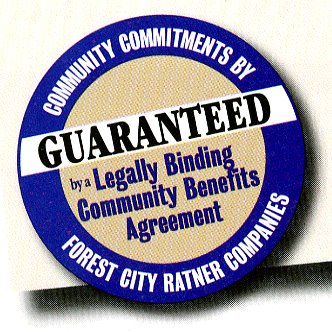 In my analysis of the Times's article yesterday about race and Atlantic Yards, I skated over the issue of the Community Benefits Agreement.
In my analysis of the Times's article yesterday about race and Atlantic Yards, I skated over the issue of the Community Benefits Agreement. The article stated:
Bruce C. Ratner, Forest City’s chief executive, is white, as are most of his executives. Several local community organizations with black leaders receive funds from the developer as part of a “community benefits agreement” they negotiated last year.
But a closer look at the coalitions lined up for and against the project, and the arguments they have mustered, suggests that Atlantic Yards has drawn no true color line in Brooklyn, but only a blur of intersecting agendas, opinions and constituencies, both black and white.
However, the Community Benefits Agreement, part of what the Times more than one year ago called part of Ratner's "modern blueprint for how to nourish - and then harvest - public and community backing," only represents some segments of the community.
What is the community? Brooklyn? Central Brooklyn? Minority Brooklyn? The Rev. Herbert Daughtry, a CBA signatory, said last spring, “The community is Brooklyn and beyond.” If so, many more groups should be included.
After all, as Bettina Damiani of Good Jobs New York told the City Council 5/26/05:
The BAY [Brooklyn Atlantic Yards] project is the first project we know of in New York City in which the developer has advertised that he seeks to participate in a Community Benefits Agreement (CBA). As a sponsored project of Good Jobs First, which provided support for the CBAs negotiated in California and continues to act as a clearinghouse for information on CBAs, we feel it is important to draw the Council’s attention to several major differences between CBAs as they have been used in other parts of the country and the series of negotiations that FCRC is calling a CBA.
Perhaps the most striking is that elsewhere CBAs are negotiated by one broad coalition of groups that would otherwise oppose a project, a coalition that includes labor and community organizations representing a variety of interests. The coalition hammers out its points of unity in advance and then each member holds out on settling on its particular issue until the issues of the other members are addressed. This way, the bargaining power of each group is used for the benefit of the coalition as a whole.
 In the BAY case, several groups, all of which have publicly supported the project already, have each engaged in what seem to be separate negotiations on particular issues.
In the BAY case, several groups, all of which have publicly supported the project already, have each engaged in what seem to be separate negotiations on particular issues.About that brochure
Also, anonymous blogger Dreadnaught points out that, despite the denial to the Times by Forest City Ratner spokesman Joe DePlasco that the developer has tried to use race, the most recent brochure promoting affordable housing featured only black faces. (Actually, racial identification can be ambiguous, so let's say that they're all minorities.)
Comments
Post a Comment